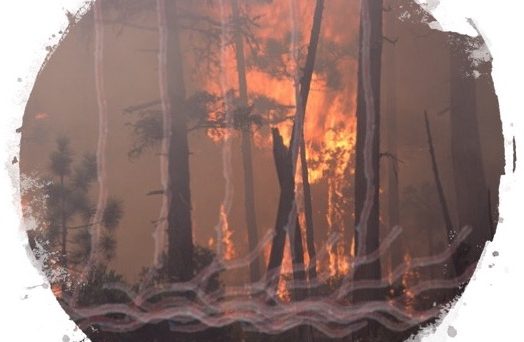
Image of Borrelia bacteria (from Wikimedia Commons) superimposed on a wildfire (from Wikimedia Commons)
Background
Wildfire regulates ecological processes and systems by forming vegetation gaps, enriching the soil and other nutrient cycles, and creating new ecological niches. Of course, fire has been critical for the advancement of Homo sapiens too (hurray for cooked food and electricity), but we have also come to fear its destructive power. Our fear of fire led to the practice of wildfire suppression, which unfortunately has significantly backfired (pun intended). Wildfire suppression combined with a warming climate has led to recent wildfires burning far longer and at a higher intensity than ever before. These wildfires have caused mass destruction of natural areas and human settlements around the globe. But what about the parasites? How does wildfire affect parasite community composition, transmission dynamics, and in turn, disease prevalence?
Fire for human disease prevention
Research on parasites and fire appears to take a predominantly applied approach in which the ultimate goal is to reduce human disease. Many studies focus on how ‘prescribed fires’ (fire set on purpose to reduce risk of extreme burning events) might reduce disease transmission by targeting arthropod vector populations and/or their parasite burdens.
Using fire to alleviate pest infestations is an old, if not ancient practice, and the subject is reviewed from an ‘annihilate all the parasites’ perspective. In a search of the recent literature, I noticed a lot of attention paid to the effect of prescribed burns on tick abundance and, in turn, tick-borne pathogens. Many studies have found tick abundance and/or density in burned areas to be lower than in unburned areas, but the time scale at which this difference persists is not well defined. There has been a lack of studies that directly measured parasite prevalence but three recent studies have begun to ‘shift inward.’ These studies focused on two tick-borne bacteria genera encompassing species that cause human disease, Borrelia (Lyme disease) and Rickettsia (spotted fever, typhus, and anaplasmosis).
In one study, scientists compared Borrelia prevalence in western black-legged ticks (Ixodes pacificus), woodrats (Neotoma fuscipes), and deer mice (Peromyscus maniculatus) collected from burned and unburned areas for three years after a wildfire in southern California. While Borrelia incidence was too low make any inferences (2/349 ticks and 2/72 deer mice), all infected individuals were collected in the burned areas, suggesting that there may be associations between temporary increased pathogen incidence and fire. Another study suggested that increased pathogen abundance following fire could be due to fire-driven increases in host aggregation, although this pattern obviously needs to be investigated on a larger scale.

In the southeastern U.S., prevalence of Rickettsia in lone star ticks (Amblyomma americanum) was significantly lower in ticks from burned sites compared to those from unburned sites. The authors of the study suggested that burned sites might significantly alter the microclimate such that temperature or humidity within the tick become unsuitable for the bacterial pathogen to develop. Given the marked difference in vegetation before and after a wildfire; noticeable differences in microclimate that could affect small creatures and their parasites seem possible. Similarly, another study comparing Rickettsia incidence in lone star ticks between sites that had undergone prescribed burns and those that did not also found a lower incidence of the bacteria in burned areas.
While these findings are too localized and short term to make broadly applicable inferences, they hint that there is much to discover about the interaction between ticks, their bacterial infections, the microclimate, and fire. And what about the tradeoffs? Could evidence that prescribed burns reduce tick-borne prevalence justify regular prescribed burns for this purpose? What are the tradeoffs for receiving that benefit?
The problem of scale
Some scientists argue that information generated through studies of wild and prescribed fire needs to be examined on a larger spatial and temporal scale. But what time scale is appropriate for studying the effects of an ancient phenomenon? What spatial scale is appropriate for studying a wildfire that can leap across a continent in a matter of days?
Scale then feels like the obstacle to understanding fire and parasites, beyond simple annihilation of local vector populations through small-scale burning. Scale also likely explains the sparsity of process-driven or mechanistic studies that use a more traditional ecological framework. But perhaps therein lies the answer: shift the focus from applied ecology to good old ecology and generate an understanding beyond fire-related fluxes in host and vector populations. Research questions directed toward mechanisms and processes rather than short-cutting around the underpinnings of the system might still yield valuable information that could be applied to disease control. However, this also begs the question: is disease control all that matters? Or is there also value in the knowledge itself?

Comments